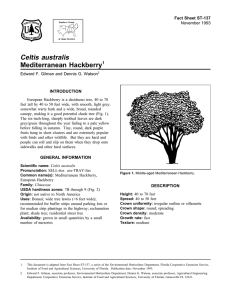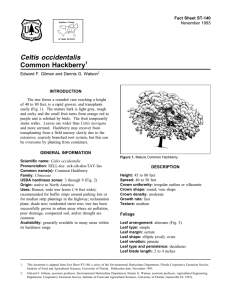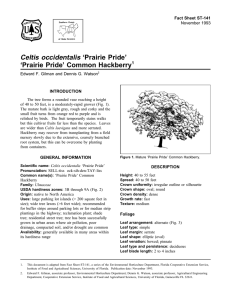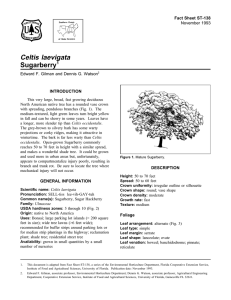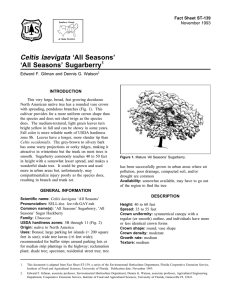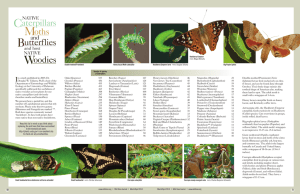Celtis sinensis Japanese Hackberry Fact Sheet ST-142 1
advertisement
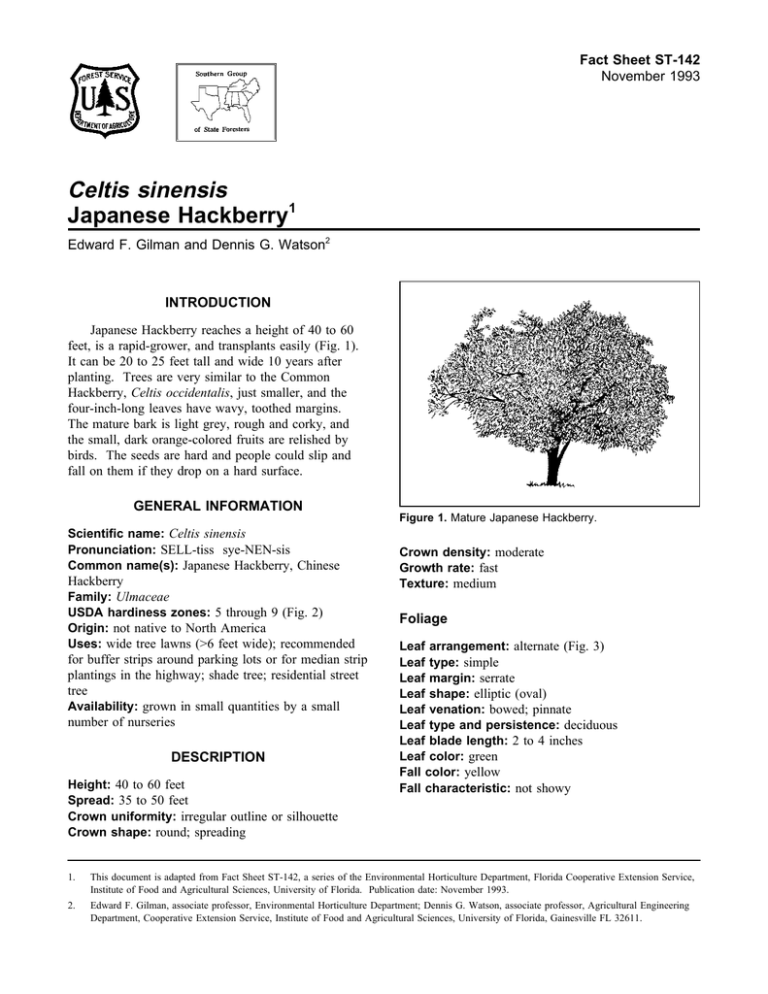
Fact Sheet ST-142 November 1993 Celtis sinensis Japanese Hackberry1 Edward F. Gilman and Dennis G. Watson2 INTRODUCTION Japanese Hackberry reaches a height of 40 to 60 feet, is a rapid-grower, and transplants easily (Fig. 1). It can be 20 to 25 feet tall and wide 10 years after planting. Trees are very similar to the Common Hackberry, Celtis occidentalis, just smaller, and the four-inch-long leaves have wavy, toothed margins. The mature bark is light grey, rough and corky, and the small, dark orange-colored fruits are relished by birds. The seeds are hard and people could slip and fall on them if they drop on a hard surface. GENERAL INFORMATION Scientific name: Celtis sinensis Pronunciation: SELL-tiss sye-NEN-sis Common name(s): Japanese Hackberry, Chinese Hackberry Family: Ulmaceae USDA hardiness zones: 5 through 9 (Fig. 2) Origin: not native to North America Uses: wide tree lawns (>6 feet wide); recommended for buffer strips around parking lots or for median strip plantings in the highway; shade tree; residential street tree Availability: grown in small quantities by a small number of nurseries DESCRIPTION Height: 40 to 60 feet Spread: 35 to 50 feet Crown uniformity: irregular outline or silhouette Crown shape: round; spreading Figure 1. Mature Japanese Hackberry. Crown density: moderate Growth rate: fast Texture: medium Foliage Leaf arrangement: alternate (Fig. 3) Leaf type: simple Leaf margin: serrate Leaf shape: elliptic (oval) Leaf venation: bowed; pinnate Leaf type and persistence: deciduous Leaf blade length: 2 to 4 inches Leaf color: green Fall color: yellow Fall characteristic: not showy 1. This document is adapted from Fact Sheet ST-142, a series of the Environmental Horticulture Department, Florida Cooperative Extension Service, Institute of Food and Agricultural Sciences, University of Florida. Publication date: November 1993. 2. Edward F. Gilman, associate professor, Environmental Horticulture Department; Dennis G. Watson, associate professor, Agricultural Engineering Department, Cooperative Extension Service, Institute of Food and Agricultural Sciences, University of Florida, Gainesville FL 32611. Celtis sinensis -- Japanese Hackberry Page 2 Figure 2. Shaded area represents potential planting range. Flower Flower characteristics: inconspicuous and not showy; spring flowering weak and tends to break Current year twig color: brown; green Current year twig thickness: thin Culture Fruit Light requirement: tree grows in part shade/part sun; Fruit Fruit Fruit Fruit Fruit shape: round length: < .5 inch covering: fleshy color: orange characteristics: attracts birds; attracts squirrels and other mammals; inconspicuous and not showy; fruit, twigs, or foliage cause significant litter Trunk and Branches Trunk/bark/branches: bark is thin and easily damaged from mechanical impact; droop as the tree grows, and will require pruning for vehicular or pedestrian clearance beneath the canopy; showy trunk; should be grown with a single leader; no thorns Pruning requirement: requires pruning to develop strong structure Breakage: susceptible to breakage either at the crotch due to poor collar formation, or the wood itself is tree grows in full sun Soil tolerances: clay; loam; sand; slightly alkaline; acidic; occasionally wet; well-drained Drought tolerance: high Other Roots: surface roots can lift sidewalks or interfere with mowing Winter interest: tree has winter interest due to unusual form, nice persistent fruits, showy winter trunk, or winter flowers Outstanding tree: not particularly outstanding Invasive potential: little, if any, potential at this time Pest resistance: long-term health usually not affected by pests Celtis sinensis -- Japanese Hackberry Page 3 other vehicles, and keep grass away from the base of the trunk so string trimmers will not cause injury. No leaf galls form on the foliage of this species which is quite unlike other species of Hackberry. But large-diameter surface roots can form (particularly in poorly-drained soil) raising sidewalks and making mowing grass difficult. Locate the tree eight feet or more from a sidewalk or street to help keep them intact. Japanese Hackberry will grow rapidly in a variety of soil types from moist, fertile soils to hot, dry locations in the full sun. It is wind- and droughttolerant once established. Propagation is by seed or cuttings. Pests and Diseases No pests or diseases are of major concern. If this tree responds similarly to Common Hackberry, the trunk can rot following mechanical injury. Not seen with leaf gall which is so common on Celtis occidentalis. Figure 3. Foliage of Japanese Hackberry. USE AND MANAGEMENT Skilled pruning is required several times during the first 15 years of life to prevent formation of weak branch crotches and multiple trunks. It could be used in street plantings where there is plenty of soil space since it tolerates most soils and grows in sun or partial shade, but branches may break out from the trunk if proper pruning and training is not conducted early in the life of the tree. The trunk is often injured if the tree is planted too close to the street in a restricted soil space. Hackberry has a reputation for internal trunk rot, particularly following mechanical injury to the trunk. Locate the tree so it will not be injured by mowing equipment or
